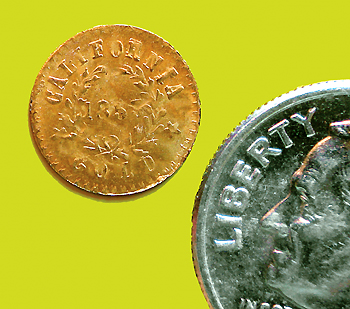California Gold in Small Denominations
|
"Making Cents"
The Signal
Saturday, September 24, 2005
| D |
The basic designs were a Liberty head on the obverse ("heads" side) and the denomination on the reverse ("tails" side) within a wreath. A few designs show an Indian head on one side, and one type is known with George Washington's head on the obverse.
Each denomination came in two formats: round and octagonal. Many fantasy and replica pieces exist; most are modern-made and often show a bear on one side.
The genuine coins were declared not legal tender by the federal government in 1864, but apparently they continued to circulate throughout the West for some years later.
The 25-cent piece is the smallest American coin in size, followed by the 50-cent piece. The gold dollars closely matched the size and fineness of the federally issued gold dollars of the same era.
There are several reference books on the subject, such as "California Fractional Gold" by David Doering (1982) and "California Gold: Dollars, Half Dollars, Quarter Dollars" by Kenneth Lee (1979).
All told, there are some 500 variations of these six basic designs, and generally the most common pieces in Extra Fine condition are valued as follows:
25 cents round: $135 to $450;
25 cents octagonal: $125 to $425;
50 cents round: $135 to $160;
50 cents octagonal: $125 to $800;
Dollar round: $500 to $1,600;
Dollar octagonal: $325 to $1,550.
Actual auction prices tend to be higher. There are various makers' initials and die varieties that often raise the values considerably. Further, these tiny pieces, which are much smaller than a dime and much thinner, are easily bent, and many specimens have been straightened out after being bent. Minor damage is also common, reducing the market value. Many have been made into jewelry and soldered onto chains or made into engraved pieces.
A collector wishing to put together a "type set" needs but six coins — one of each major type — and perhaps a sample of the Washington head and Indian head types to make a very nice set of 12 pieces.
For basic values of each type, refer to the "Guide Book of United States Coins" (aka the "Red Book") by R.S. Yeoman, published annually.
Souvenir shops in public places such as Old Town in Sacramento and El Pueblo in Los Angeles do not sell real California gold pieces. Fantasy or counterfeit pieces are not made of gold and often feature a bear in the design. They sometimes come in sets of six types mounted in a cardboard holder with some description of why California needed small gold coins at the time. These sets are purely souvenirs, not numismatic items.
The real coins should be bought only at major coin auctions or from reputable coin dealers with a money-back guarantee.
Dr. Sol Taylor of Sherman Oaks is president of the Society of Lincoln Cent Collectors and author of The Standard Guide to the Lincoln Cent. Click here for ordering information.
©2005, THE SIGNAL · ALL RIGHTS RESERVED.
